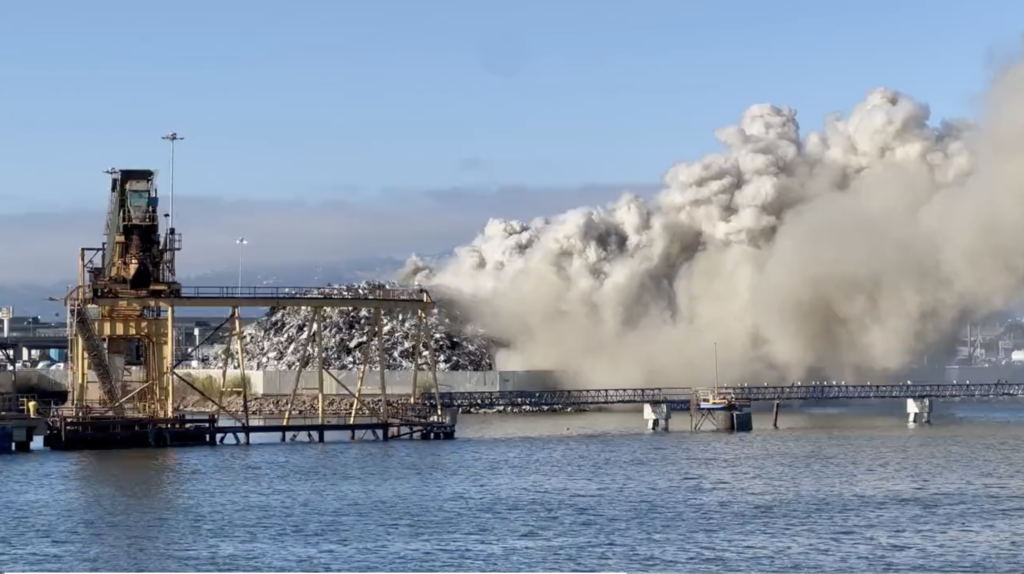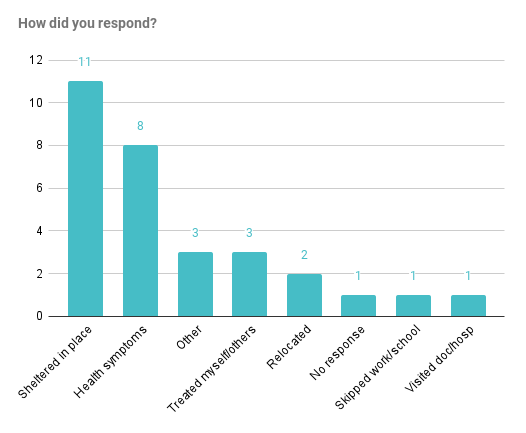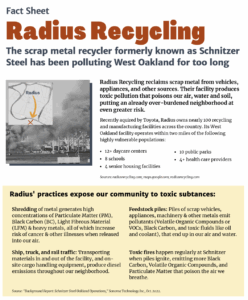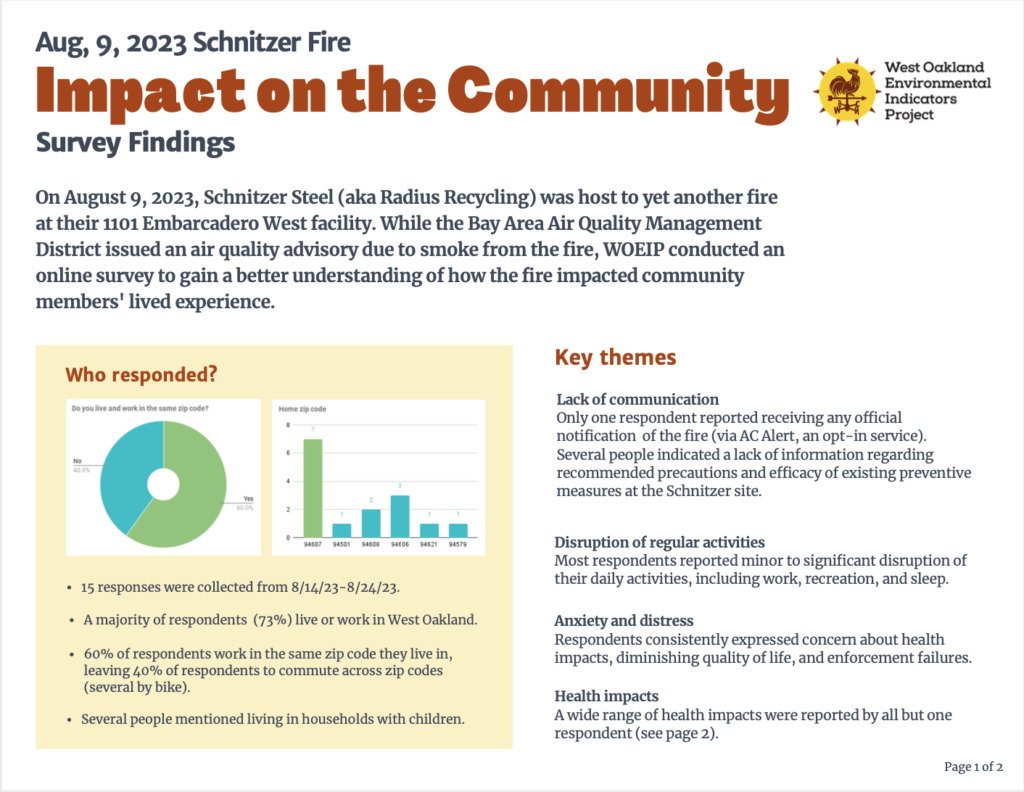On August 9, 2023, Radius Recycling (formerly known as Schnitzer Steel) was host to yet another fire at their scrap metal facility in West Oakland. The fire’s smoke quickly spread across Oakland, reaching as far as Larkspur to the north and Milpitas to the south. However, this wasn’t the first time Radius violated legal regulations, poisoning thousands of people, many of whom live in already pollution-burdened communities. WOEIP has been fighting for tighter regulation, stronger enforcement, and cleaner practices at Radius/Schnitzer for as long as we’ve been neighbors. It’s well past time for Radius to clean up or get out.
Jump to…
- Latest updates: Senate Bill 1234 has been successfully pulled!
- What is Schnitzer Steel
- The impacts of waste recycling on local communities
- What can we do about it?
- Get Schnitzer Steel news in your inbox

Latest updates
- Aug 15, 2024: Thanks to pressure from California’s overburdened communities, Sen. Ben Allen has pulled Senate Bill 1234, the industry-sponsored legislation that weakened regulation for California’s large metal shredders. WOEIP and our allies will be working directly with Senator Allen and his colleagues to revise the bill so it addresses the needs of the communities most impacted by these historical polluters.
- July 23, 2024: WOEIP has learned of fast-tracked legislation ↗️ sponsored by California’s major metal shredders that would effectively strip local agencies of the ability to regulate the industry, codify many of the industry’s toxic emissions as non-hazardous in contradiction of scientific evidence, and undermine the public review process for impacted communities across the state. We need your help to stop SB 1234! Tell Senator Allen to pull his legislation until the community can engage ↗️.
- July 23, 2024: Alameda County DA Pamela Price charges Radius Recycling and two of its employees with 10 criminal counts, including three felonies, for its handling of the August 2023 fire.
- WOEIP demands BAAQMD apply the Civil Rights Act to Radius/Schnitzer: On behalf of WOEIP, Co-director Brian Beveridge and WOCAP Steering Committee Member Richard Grow (EPA, retired) formally submitted a demand letter to the Bay Area Air Quality Management District requesting that the District consider federal Title VI requirements of the Civil Rights Act and address them on the record in any proposed actions on the Schnitzer permits. Read the full letter.
- On Feb. 7, WOEIP joined the third convening of the EPA Rapid Response Task Force, a collaborative effort bringing together more than a dozen local, regional, state, and federal agencies in response to the Aug. 9 Schnitzer Steel fire. This meeting focused mainly on permits: Schnitzer has several permits up for review by both BAAQMD and the DTSC. Sign up for updates above to receive notice when the public comment period opens for these permit reviews.
What is Radius Recycling (Schnitzer Steel)?
Radius Recycling (formerly Schnitzer Steel) is a privately-owned corporation that runs 54 scrap metal recycling plants around the country. Its 26-acre facility on the edge of West Oakland sits within two miles of more than a dozen daycare centers, eight schools, four senior housing facilities, 10 public parks, and at least four healthcare providers. For years, Radius/Schnitzer has flagrantly violated multiple environmental laws and shows no signs of stopping.
Radius’ history of violations
Radius Recycling is a notorious polluter with a long history of releasing illegal toxins into a historically marginalized community already overburdened by industrial pollution.
WOEIP’s official statement on the Aug. 9 fire
West Oakland Residents Demand Schnitzer Steel Clean Up Its Act or Get Out of Town
AUG. 10, 2023 | FOR IMMEDIATE RELEASE
West Oakland, CA — West Oakland Environmental Indicators Project (WOEIP) is as horrified and angry as our neighbors at the fire that erupted yesterday at the Schnitzer Steel scrap metal facility in West Oakland, California. However, we are not surprised. WOEIP has been fighting for tighter regulation, stronger enforcement, and cleaner practices at Schnitzer Steel for as long as we’ve been neighbors.
Schnitzer Steel—which sits within one mile of more than a dozen daycare centers, eight schools, four senior housing facilities, 10 public parks, and two hospitals—is a notorious polluter with a long history of releasing toxins into a historically Black community already overburdened by industrial pollution. It has a decades-long history of Notices of Violation from multiple Federal and State agencies, including a lawsuit brought by the California State Attorney General that required Schnitzer to install emission control systems on the mega-shredder that reduces entire automobiles into fist-size chunks. Plastic, fabrics, steel, brass and copper are extruded into huge flammable piles to await sorting and export. These piles catch fire almost yearly. The owners of Schnitzer Steel say there is nothing they can do to avoid the fires. By their account, toxic fires in Oakland are actually part of their business model.

Schnitzer itself has stated that at any given time, 70,000-80,000 tons of material may be found in outdoor piles awaiting shredding, in addition to 300-500 tons of partially processed material and 350 tons of chemically-treated material. This is what our community is breathing this morning as the fire still smolders and pollutants hang in our air.
The West Oakland community has had enough. WOEIP has been actively pushing to install on-site air monitors at the Schnitzer facility for years but continues to hit roadblocks. We urge local regulators, including the California Department of Toxic Substances Control, to classify Schnitzer’s toxic stockpiles as hazardous waste, something the company successfully lobbied against when fighting the Oakland A’s Howard Terminal. We fully support the Oakland City Council’s recent authorization of The Civil Protection Of The People Of Oakland Ordinance, which now gives the City Attorney the ability to bring civil action against polluters like Schnitzer Steel, and urge the City Attorney to seek action here.
It is the people of color, who live in the flatlands, and our youth, elders, and sick, with their increased health risks from exposure to Schnitzer’s toxic emissions, who carry the disproportionate burden of this company’s profit-driven pollution. Yet, as Oakland and Alameda residents discovered overnight and this morning, we all breathe this air.
This is why the West Oakland Environmental Indicators Project works with residents to push agencies and regulators for stricter controls and more just enforcement. It’s why we partner with local agencies, community organizations, engineers, and residents to bring cleaner infrastructure to West Oakland, such as indoor air filtration in residential housing facilities, like the one we recently installed at Saint Mary’s Center. But we cannot continue to clean up Schnitzer’s mess.
The City, State and Federal government must put a stop to this. And Schnitzer Steel must clean up its act—or get out of town.
About West Oakland Environmental Indicators Project
The West Oakland Environmental Indicators Project (WOEIP) is a resident led, community-based environmental justice organization dedicated to achieving healthy homes, healthy jobs and healthy neighborhoods for all who live, work, learn and play in West Oakland, California. Using Collaborative Problem-Solving and Community-based Participatory Research, WOEIP empowers impacted residents with the understanding and tools needed to participate in the political, social, and natural forces that impact their lives, driving change from the bottom up.
For media inquiries, please email info@woeip.org.
How scrap metal recycling impacts local communities
Scrap metal recycling is an important part of reducing California’s environmental footprint. But the industry produces significant environmental impacts of its own. Recycling facilities — including Radius Recycling — are often located near or within communities of color and low-income communities. As a result, these communities are more directly exposed to the toxins recycling produces. They pay the price with their health. Solutions to the climate crisis will never be successful as long as residential communities like West Oakland are treated as sacrificial lambs.
Impacts of the Radius Recycling plant
The Radius Recycling (formerly Schnitzer Steel) facility in West Oakland has a long history of poisoning the neighborhood.
- Shredding of metal generates high concentrations of Particulate Matter (PM), Black Carbon (BC), Light Fibrous Material (LFM) & heavy metals, all of which increase risk of cancer and other illnesses when released into our air.
- Feedstock piles: Piles of scrap vehicles, appliances, machinery and other metals emit pollutants (Volatile Organic Compounds or VOCs, Black Carbon, and toxic fluids like oil and coolant), that end up in our air and water.
- Ship, truck, and rail traffic: Transporting materials in and out of the facility, and on-site cargo handling equipment, which produces diesel emissions throughout our neighborhood.
- Toxic fires happen regularly at Schnitzer when piles ignite. This emits even more Black Carbon, Volatile Organic Compounds, and Particulate Matter that poison the air we breathe.
Impacts of the Aug. 9 fire
On August 9, 2023, Radius Recycling/Schnitzer Steel was host to yet another fire at their 1101 Embarcadero West facility. While the Bay Area Air Quality Management District issued an air quality advisory due to smoke from the fire, WOEIP conducted an online survey to gain a better understanding of how the fire impacted community members’ lived experience.

87% of respondents found themselves forced to shelter in place or relocate
all together, in an attempt to avoid the fire’s toxic fumes.
Of the 53% of respondents who experienced health symptoms, about half had to take active treatment measures (whether through self-care, care for others, or visiting a healthcare provider).
“I went outside and saw my neighbor holding her baby and staring out into the smoke. It was a disturbing image and events like this decrease the ability for that baby to live and thrive in Oakland.”
—Survey respondent
“When you look at all of the variables, race is still the most potent factor to predict where these facilities are located, more important than income or other socioeconomic factors. Even when you control for how much money people make and the price of housing, race still comes out as the number one factor in determining where toxic facilities are located.”
—Dr. Robert Bullard, “the father of Environmental Justice”


What can we do about Radius?
Polluters like Radius Recycling won’t stop on their own. WOEIP is working to bring all the forces to bear that we can to force them to clean up or get out.
The role of regulators
There are many agencies responsible for ensuring polluters like Radius/Schnitzer Steel are brought to justice. These agencies have different jurisdictions, different processes, and different laws they enforce. This means they often work separately, rather than in a unified way. WOEIP has been working directly with all of these agencies to push for greater cooperation, information sharing, and collaborative problem-solving. This includes participating in the EPA’s Rapid Response Task Force formed in response to the Aug. 9 fire.
Federal agencies
- U.S. Environmental Protection Agency (U.S. EPA)
Inspects the facility, issues federal permits, and enforces the Clean Air Act. - California Air Resources Board (CARB)
Provides air quality expertise and reviews compliance protocols. - California Department of Toxic Substances Control (DTSC)
Regulates hazardous waste facility permits, enforces state hazardous waste control laws.
California Department of Toxic Substances Control (DTSC)
Regulates hazardous waste facility permits, enforces state hazardous waste control laws. - California State Attorney General
Brings lawsuits against violators.
Regional agencies
- California Environmental Protection Agency (CalEPA)
Oversees statewide environmental justice initiatives. - Bay Area Air Quality Management District (BAAQMD)
Issues air permits, sets operational rules, approves annual air testing protocols.
- State Water Resources Control Board (SWRCB)
Requires a Storm Water Pollution Prevention Plan (SWPPP), and administers General Permit. - Alameda County District Attorney (AlCo DA)
Investigates and prosecutes civil and criminal cases.
Local agencies
- Oakland City Attorney’s Office
Litigates cases on behalf of the City of Oakland.
The role of the community
West Oakland residents have lived in the shadow and smoke of Schnitzer Steel (now Radius) for years. With the reach of the Aug. 9 fire, the wider Bay Area has begun to recognize the threat of Schnitzer on our local air quality and health. Residents from across the Bay are demanding that toxic sites like Schnitzer Steel relocate away from residential communities if they refuse to stop poisoning them.
Immediately following the Schnitzer’s Aug. 9 fire, the community rallied to lay down an ultimatum for Schnitzer Steel: clean up or get out.
WOEIP is working with community groups, and will share details about how to submit public comments when agencies open their permit decisions for review in the coming months. Sign up below to stay informed.
Get Radius/Schnitzer updates
You’ll receive our monthly newsletter and specific updates on Radius Recycling (Schnitzer Steel). If you’re already a subscriber, signing up below will simply add you the list. You can unsubscribe at any time.